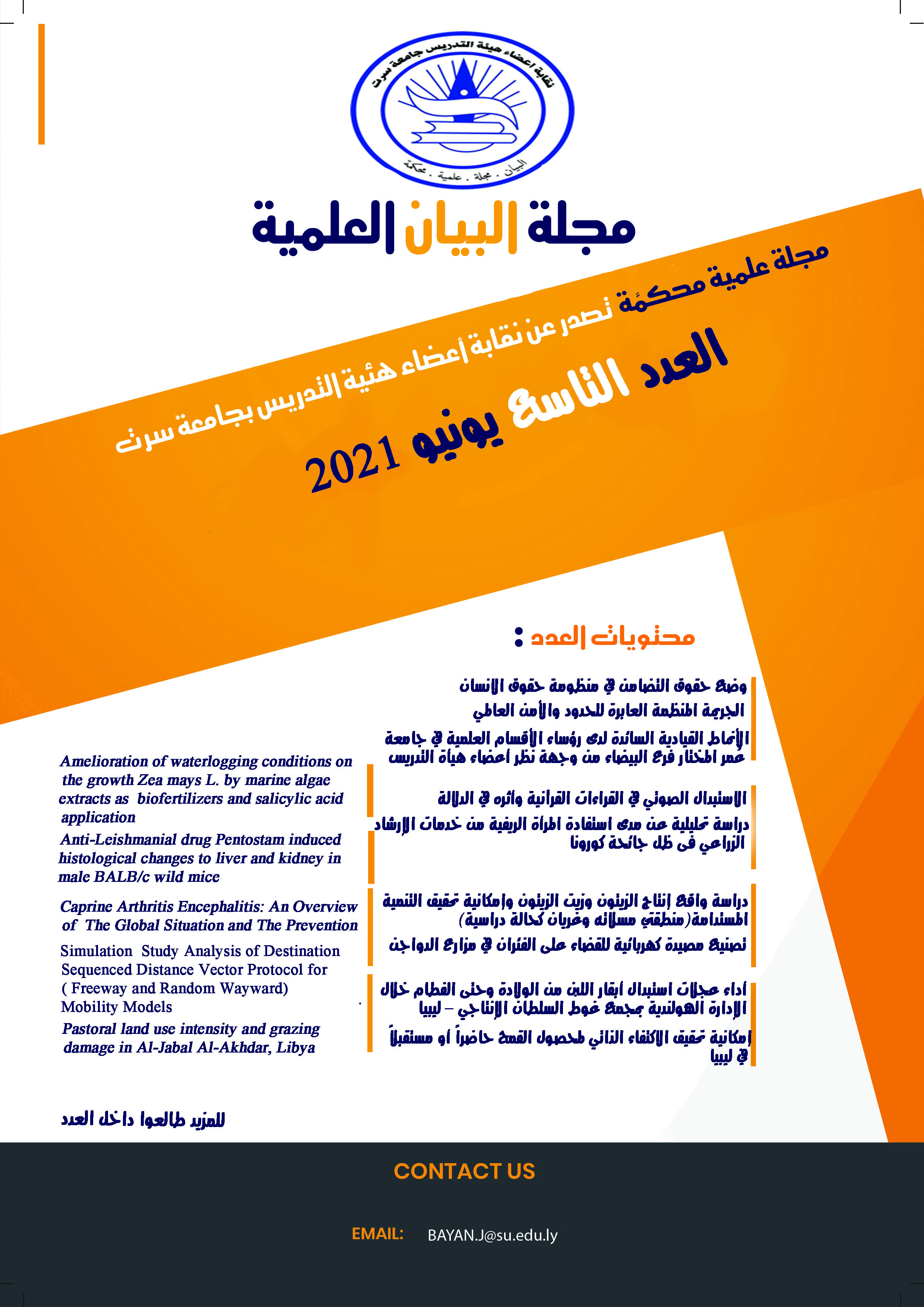Prevalence of Antibodies Against Chicken Infectious Anaemia Virus Among Free-Range Chickens in Northeastern Libya
DOI:
https://doi.org/10.37375/bsj.vi9.2328الكلمات المفتاحية:
Chicken Infectious Anaemia Virus,، Prevalence,، Free-Range Chickens,، ELISA,، Libyaالملخص
Chicken Infectious Anaemia Virus (CIAV) has expanded much significance as an immunosuppressive and economically notable emerging aetiology of chickens worldwide. CIAV is the causative agent of Chicken Infectious Anaemia (CIA), an emerging infectious disease mainly noticed in young chicks of 2-4 weeks of age, which usually acquire the infection vertically. The disease is characterised by increased mortality, reduced weight gain, anaemia, aplasia of bone marrow, atrophy of thymus and concomitant marked immunosuppression with enhanced susceptibility to other pathogens and diminished vaccine responses leading to severe economic losses. This research was achieved due to the scarceness of recent facts iabout CIAV in Libya, and it is reported in bordering country near to the study area. For this purpose, in the period of between 3rd and 6th of January 2010, a prevalence study was performed on free-range chickens with collection of 96 serum samples from 15 flocks in northeastern area-Libya, and screened for the presence of CIAV antibodies using indirect enzyme-linked Immunosorbent assay (ELISA) kit. Moreover a structured questionnaire was designed for the purpose of this research and administrated to owners to gather information on demographic and management data. The overall prevalence was 71.87%. The prevalence-within-flock ranged from 60% to 100%. There are age variation in the infection distribution was noted in third breeding interval and significantly lower than other three breeding intervals (P ≤ 0.05). The specific antibodies against CIAV in the flocks of Al-Marj suburb were significantly low (P ≤ 0.05) compared to the rest suburbs. The findings of the current study show that CIAV is widespread among village chicken populations in the surveyed area. Hence, further studies are required to evaluate the epidemiological effects and yield losses of infection in commercial chickens, and to assess the expenditure profit of prevention procedures.
المراجع
REFERENCES:
Schat, K. A., and Santen, V. (2013). Chicken Infectious Anemia. In: Diseases of Poultry. (13th Edn). Swayne DE, Glisson JR, McDougald LR, Nolan LK, David Suarez, L.D, and Nair, V. (Editors), Blackwell Publishing, Ames, Ch. 8, pp: 248-264.
Pringle, C. R., (1999). Virus taxonomy at the XI International Congress of Virology, Sydney, Australia. Arch Virol. 144, 2065-2070.
Rijsewijk, F., H. dos Santos, T. Teixeira, S. Cibulski, A. Varela, D. Dezen, A. Franco, and P. Roehe. (2011). Discovery of a genome of a distant relative of chicken anemia virus reveals a new member of the genus Gyrovirus. Arch Virol. 156:1097-1100.
dos Santos, H.F., M.B. Knak, F.L. de Castro, J. Slongo, G.A. Ritterbusch, T.A.P. Klein, P.A. Esteves, A.D. Silva, I.M. Trevisol, E.A.W. Claassen, L.A.H.M. Cornelissen, M. Lovato, A.C. Franco, P.M. Roehe, and F.A.M. Rijsewijk. (2012). Variants of the recently discovered avian gyrovirus 2 are detected in Southern Brazil and The Netherlands. Vet Microbiol. 155(2-4):230-6.
Meehan, B. M., Todd, D., Creelan, J. L., Earle, J. A. P., Hoey, E. M., and McNulty, M. S. (1992). Characterization of viral DNAs from cells infected with chicken anaemia agent: sequence analysis of the cloned replicative form and transfection capabilities of cloned genome fragments. Arch Virol. 124, 301-319.
Goryo, M., H. Sugimura, S. Matsumoto, T. Umemura, and C. Itakura. (1985). Isolation of an agent inducing chicken anaemia. Avian Pathol. 14: 483-496.
Toro, H., Ramirez, A.M., Larenas, J. (1997). Pathogenicity of chicken anemia virus (isolate 10343) for young and older chickens. Avian Pathol. 26: 485-499.
Emikpe, B., D. Oluwayelu, O. Ohore, O. Oladele and A. Oladokun, (2005). Serological evidence of chicken anemia virus infection in Nigerian indigenous chickens. Onderstepoort Journal of Veterinary Research. 72, 101-103.
Oluwayelu, D. and D. Todd, (2008). Rapid identification of chicken anemia virus in Nigerian backyard chickens by polymerase chain reaction combined with restriction endonuclease analysis. African Journal of Biotechnology. 7, 271-275.
Ducatez M,., H. Chen, Y. Guan and C. Muller, (2008). Molecular epidemiology of chicken anemia virus (CAV) in southeastern Chinese live birds markets. Avian Dis. 52, 68-73.
De Wit, J., J. Van Eck, R. Crooijmans and A. Pijpers, (2004). A serological survey for pathogens in old fancy chicken breeds in central and eastern part of The Nether-lands. Tijdschrift voor Diergeneeskunde. 129, 324-327.
Alexander, D., (2000). A review of avian influenza in different bird species. Vet Microbiol. 74, 3-13.
Hoop, R., (1992). Persistence and vertical trans-mission of chicken anaemia agent in experimentally infected laying hens. Avian Pathol. 21, 493-501.
Brentano, L., Mores, N., Wentz, I., Chandratilleke, D., Schat, K.A. (1991). Isolation and identification of chicken infectious anemia virus in Brazil. Avian Dis. 35: 793-800.
Engstrom, B. and M. Luthman, (1984). Blue wing disease of chickens: Signs, pathology and natural transmission. Avian Pathol. 13, 1-12.
McNulty, M., T. Connor, F. McNeilly, K. Kirkpatrick and J. McFerran, (1988). A serological survey of domestic poultry in the United Kingdom for antibody to chicken anaemia agent. Avian Pathol. 17, 315-324.
Canal, C. W., D. J. Ferreira, M. Macagnan, L. C. B. Fallavena, H. L. S. Moraes, V. B. Wald. (2004). Prevalence of antibodies against chicken anemia virus (CAV) in broiler breeders in Southern Brazil. Pesq. Vet. Bras. 24: 89-92.
Gerish, E. KH., (2012). Epidemiological Study on Chicken Infectious Anaemia Virus in Broiler Breeders in Libya. Thesis (M.V.Sc), Department of Preventive Medicine, Faculty of Veterinary Medicine, University of Tripoli.














